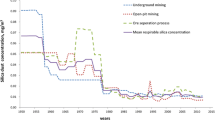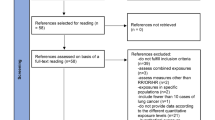Abstract
Objectives: Silica is one of the most common occupational exposures worldwide. In 1997 the International Agency for Research on Cancer (IARC) classified inhaled crystalline silica as a human carcinogen (group 1), but acknowledged limitations in the epidemiologic data, including inconsistencies across studies and the lack of extensive exposure–response data. We have conducted a pooled exposure–response analysis of 10 silica-exposed cohorts to investigate lung cancer.
Methods: The pooled cohort included 65,980 workers (44,160 miners, 21,820 nominees), and 1072 lung cancer deaths (663 miners, 409 nonminers). Follow-up has been extended for five of these cohorts beyond published data. Quantitative exposure estimates by job and calendar time were adopted, modified, or developed to permit common analyses by respirable silica (mg/m3) across cohorts.
Results: The log of cumulative exposure, with a 15-year lag, was a strong predictor of lung cancer (p = 0.0001), with consistency across studies (test for heterogeneity, p = 0.34). Results for the log of cumulative exposure were consistent between underground mines and other facilities. Categorical analyses by quintile of cumulative exposure resulted in a monotonic trend with odds ratios of 1.0, 1.0, 1.3, 1.5, 1.6. Analyses using a spline curve also showed a monotonic increase in risk with increasing exposure. The estimated excess lifetime risk (through age 75) of lung cancer for a worker exposed from age 20 to 65 at 0.1 mg/m3 respirable crystalline silica (the permissible level in many countries) was 1.1–1.7%, above background risks of 3–6%.
Conclusions: Our results support the decision by the IARC to classify inhaled silica in occupational settings as a carcinogen, and suggest that the current exposure limits in many countries may be inadequate. These data represent the first quantitative exposure–response analysis and risk assessment for silica using data from multiple studies.
Similar content being viewed by others
References
International Agency for Research on Cancer (IARC) (1997) Monographs on the Evaluation of Carcinogenic Risks to Humans, vol. 68: Silica, Some Silicates, Coal Dust and Para-Aramid Fibrils. Lyon: International Agency for Research on Cancer.
Hessel P, Gamble J, Gee J, et al. (2000) Silica, silicosis, and lung cancer: a response to a recent working group report. J Occup Environ Med 42: 704–720.
Friedenreich C (1993) Methods for pooled analyses of epidemiologic studies. Epidemiology 4: 295–302.
Gordon I, Boffetta P, Demers P (1998) A case study comparing a meta-analysis and a pooled analysis of studies of sinonasal cancer among wood workers. Epidemiology 9: 518–524.
Meijers J, Swaen G, Slangen J (1996) Mortality and lung cancer in ceramic workers in the Netherlands. Am J Ind Med 30: 26–30.
Reid P, Sluis-Cremer G (1996) Mortality of white South African gold miners. Occup Environ Med 49: 459–464.
Cherry N, Burgess G, Turner S, McDonald J (1998) Crystalline silica and risk of lung cancer in the potteries. Occup Environ Med 55: 779–785.
Harrison J, Brower P, Attfield M, et al. (1997) Surface composition of respirable silica particles in a set of US anthracite and bituminous coal mine dusts. J Aerosol Sci 28: 689–696.
Fubini B, Bolis V, Cavenago A, Volante M (1995) Physicochemical properties of crystalline silica dusts and their possible implication in various biological response. Scand J Work Environ Health 21(Suppl. 2): 9–14.
Miller B, Buchanan D, Hurley J, et al. (1997) The effects of exposure to diesel fumes, low-level radiation, respirable dust and quartz, on cancer mortality in coalminers. Institute of Occupational Medicine Report TM/97/04, Edinburgh.
Steenland K, Brown D (1995) Mortality study of gold miners exposed to silica and non-asbestiform amphibole mineral: an update with 14 more years of follow-up. Am J Ind Med 27: 217–229.
Koskela R, Klockars M, Laurent H, Holopainen M (1994) Silica dust exposure and lung cancer. Scand J Work Environ Health 20: 407–416.
Chen J, McLaughlin JK, Zhang J, et al. (1992) Mortality among dust-exposed Chinese mine and pottery workers. J Occup Med 34: 311–316.
Steenland K, Sanderson W, Deddens J (2001) Lung cancer among industrial sand workers exposed to high levels of silica. Am J Epidemiol 153: 695–703.
de Klerk N, Musk A (1998) Silica, compensated silicosis, and lung cancer in Western Australian gold miners. Occup Environ Med 55: 243–248.
Costello J, Graham W (1988) Vermont granite workers' mortality study. Am J Indust Med 13: 483–497.
Checkoway H, Heyer N, Seixas N, et al. (1997) Exposure-response associations of silica with non-malignant respiratory disease and lung cancer mortality in the diatomaceous earth industry. Am J Epidemiol 145: 680–688.
Rice F, Park R, Stayner L, Smith R, Gilbert S, Checkoway H (2001) Crystalline silica exposure and lung cancer mortality in diatomaceous earth industry workers: a quantitative risk assessment. Occup Environ Med 58: 38–45.
Seixas N, Heyer N, Welp E, Checkoway H (1997) Quantification of historical exposures in the diatomaceous earth industry. Ann Occup Hyg 41: 591–604.
Hnizdo E, Sluis-Cremer G (1991) Silica exposure, silicosis, and lung cancer: a mortality study of South African gold miners. Br J Indust Med 48: 53–60.
Hnizdo E, Murray J, Klempman S (1997) Lung cancer in relation to exposure to silica dust, silicosis, and uranium production in S. Africa gold miners. Thorax 52: 271–275.
Roscoe R, Steenland K, Halperin W, Beaumont J, Waxweiler R (1989) Lung cancer mortality among nonsmoking uranium miners exposed to radon daughters. JAMA 262: 629–633.
Hornung R, Deddens K, Roscoe R (1998) Modifiers of lung cancer risk in uranium miners from the Colorado Plateau. Health Phys 74: 12–21.
Steenland K, Brown D (1995) Silicosis among gold-miners: exposure-response analysis and risk assessment. Am J Public Health 85: 1372–1377.
McDonald J, Gibbs G, Liddell W, McDonald A (1978) Mortality after long-term exposure to cummingtonite-gruncrite. Am Rev Respir Dis 118: 271–277.
McDonald A, McDonald J, Rando R, Hughes J, Weill H (2001) Cohort mortality study of North American industrial sand workers. I. Mortality from lung cancer, silicosis, and other causes. Ann Occup Hyg 45: 193–200.
Banks D, Morring K, Boehlecke B (1981) Silicosis in the 1980s. J Am Indust Hyg Assoc 42: 77–79.
Banks D, Morring K, Boehlecke B, Rochelle A, Merchant J (1981) Silicosis in silica flour workers. Am Rev Respir Dis 124: 445–450.
Sanderson W, Steenland K, Deddens J (2000) Historical respirable quartz exposures of industrial sand workers: 1947–1996. Am J Indust Med 38: 1–10.
Hewson G (1993) Estimates of silica exposure among metalliferous miners in Western Australia (1925–1993). Department of Minerals and Energy of Western Australia, Perth.
Davis L, Wegman D, Monson R, Froines J (1983) Mortality experience of Vermont granite workers. Am J Indust Med 4: 704–723.
Eisen A, Smith T, Wegman D, Louis T, Froines J (1984) Estimation of long term dust exposures in the Vermont granite sheds. J Am Indust Hyg Assoc 45: 89–94.
Theriault G, Burgess W, DiBerardinis L, Peters J (1974) Dust exposure in the Vermont granite sheds. Arch Environ Health 28: 12–17.
Dosemcci M, Chen J, Hearl F, et al. (1993) Estimating historical silica exposure among mine and pottery workers in the People's Republic of China. Am J Indust Med 24: 55–66.
McLaughlin J, Chen J-Q, Dosemeci M, et al. (1992) A nested case-control study of lung cancer among silica exposed workers in China. Br J Indust Med 49: 167–171.
Zhuang Z, Hearl F, Chen W, et al. (2001) Estimating historical respirable crystalline silica exposure for Chinese pottery workers, iron/copper, tin, and tungsten miners. An Occup Hyg (in press).
Koskela R (1995) Association of silica dust exposure with lung cancer and other disease. Dissertation, University of Tampere, Tampere, Finland.
Steenland K, Spaeth S, Cassinelli R, et al. (1998) NIOSH life table program for personal computers. Am J Indust Med 34: 517–518.
Ferlay J, Parkin D, Pisani P (1998) Globocan I: Cancer Incidence and Mortality Worldwide. Lyon: IARC Press.
SAS (1991) SAS User's Guide: Statistics (Version 6.07). Cary, NC: SAS Institute.
Steenland K, Deddens J (1997) Increased precision using counter-matching in nested case-control studies. Epidemiology 8: 238–242.
Harrell FE, Lee KL, Pollock BG (1988) Regression models in clinical studies: determining relationships between predictors and response. J Natl Cancer Inst 80: 1198–1202.
Gail M (1975) Measuring the benefits of reduced exposure to environmental carcinogens. J Chron Dis 28: 135–147.
Stayner L, Smith R, Thun M, Schnorr T, Lemen R (1992) A dose-response analysis and quantitative assessment of lung cancer risk and occupational cadmium exposure. Anns Epidemiol 2: 177–194.
Hornung R, Meinhardt T (1987) Quantitative risk assessment of lung cancer in US uranium miners. Health Phys 52: 417–430.
Steenland K, Deddens J, Stayner L (1998) Diesel exhaust and lung cancer in the trucking industry exposure-response analysis and risk assessment. Am J Indust Med 34: 220–228.
Hertz-Piccioto I, Smith A (1993) Observations on the dose-response curve for arsenic exposure and lung cancer. Scand J Work Environ Health 19: 217–226.
Steenland K, Piacitelli L, Deddens J, Fingerhut M, Chang Lihlng (1999) Cancer, heart disease, and diabetes in workers exposed to 2,3,7,8-tetrachlorodibenzo-p-dioxin (TCDD): an update and exposure-response analysis of the NIOSH TCDD cohort. J Natl Cancer Inst 91: 779–786.
Siemiatycki J, Wacholder S, Dewar R, Cardis E, Greenwood C, Richardson L (1988) Degree of confounding bias related to smoking, ethnic group, and socioeconomic status in estimates of the association between occupation and cancer. J Occup Med 30: 617–625.
Checkoway H, Franzblau A (2000) Is silicosis required for silica-associated lung cancer? Am J Indust Med 37: 252–259.
Flegal K, Keyl P, Nieto J (1991) Differential misclassification arising from nondifferential errors in exposure measurement. Am J Epidemiol 134: 1233–1244.
Correa-Villasenor A, Steward W, Franco-Marian F, Seacat H (1995) Bias from nondifferential misclassification in case-control studies with three exposure levels. Epidemiology 6: 276–281.
Steenland K, Deddens J (2000) Biases in estimating the effect of cumulative exposure in linear and log-linear models when exposure is subject to Berkson-type errors. Scand J Work Environ Health 26: 37–43.
Deddens J, Hornung R (1995) Quantitative examples of continuous exposure measurement errors that bias risk estimates away from the null. In: Smith C, Christiani D, Kelsey K, eds. Chemical Risk Assessment of Occupational Health. London: Auburn, pp. 77–85.
Gibb H, Lees P, Pinsky P, Rooney B (2000) Lung cancer among workers in chromium chemical production. Am J Indust Med 38: 115–116.
Enterline P, Henderson V, Marsh G (1987) Exposure to arsenic and respiratory cancer. Am J Epidemiol 25: 929–938.
ICNCM (International Committee on Nickel Carcinogenesis in Man) (1990) Report of the International Committee on Nickel Carcinogenesis in Man. Scand J Work Environ Health 16: 1–84.
Author information
Authors and Affiliations
Rights and permissions
About this article
Cite this article
Steenland, K., Mannetje, A., Boffetta, P. et al. Pooled exposure–response analyses and risk assessment for lung cancer in 10 cohorts of silica-exposed workers: an IARC multicentre study. Cancer Causes Control 12, 773–784 (2001). https://doi.org/10.1023/A:1012214102061
Issue Date:
DOI: https://doi.org/10.1023/A:1012214102061




